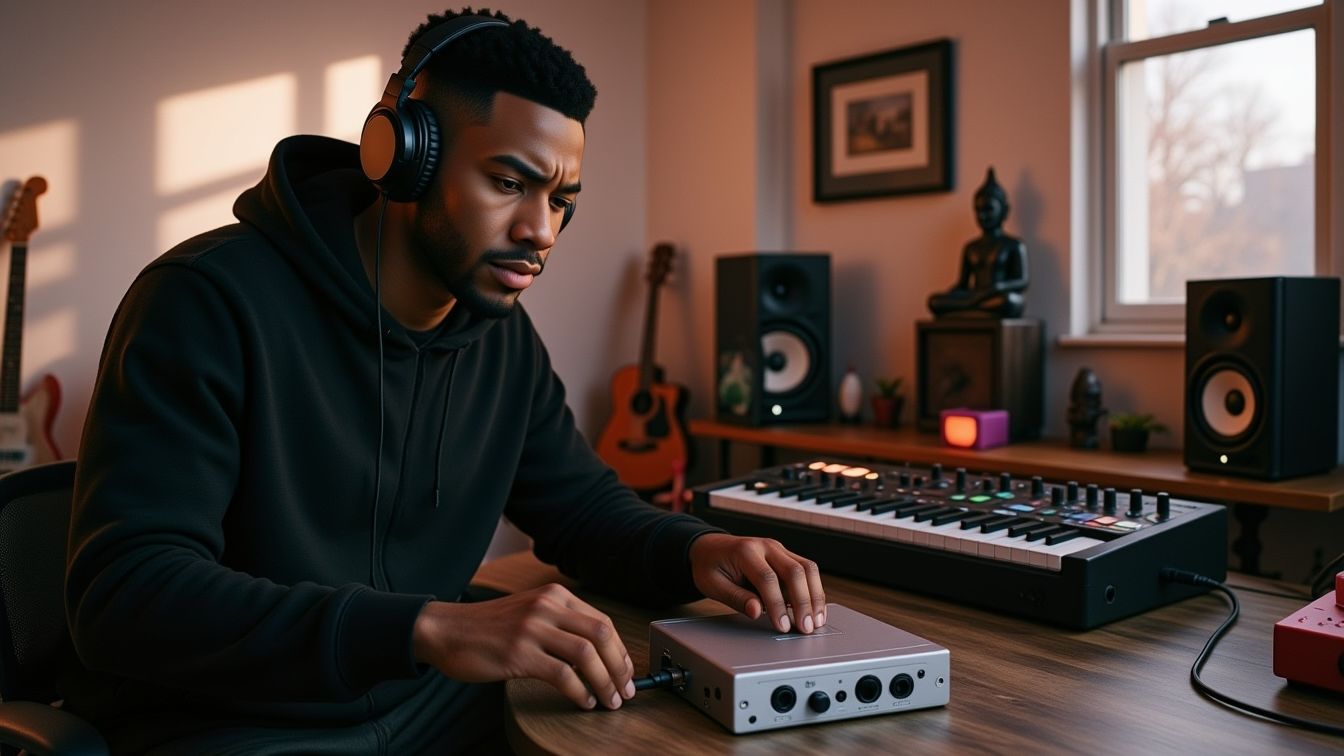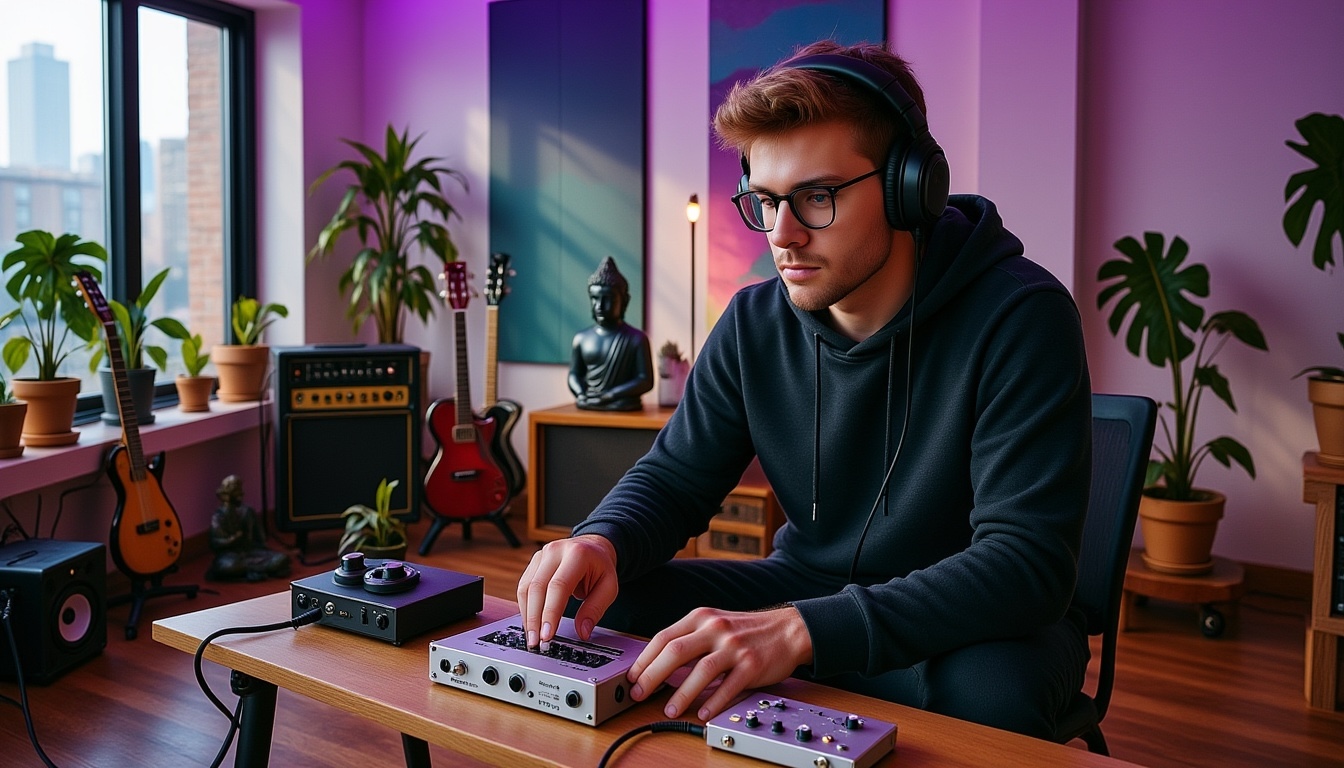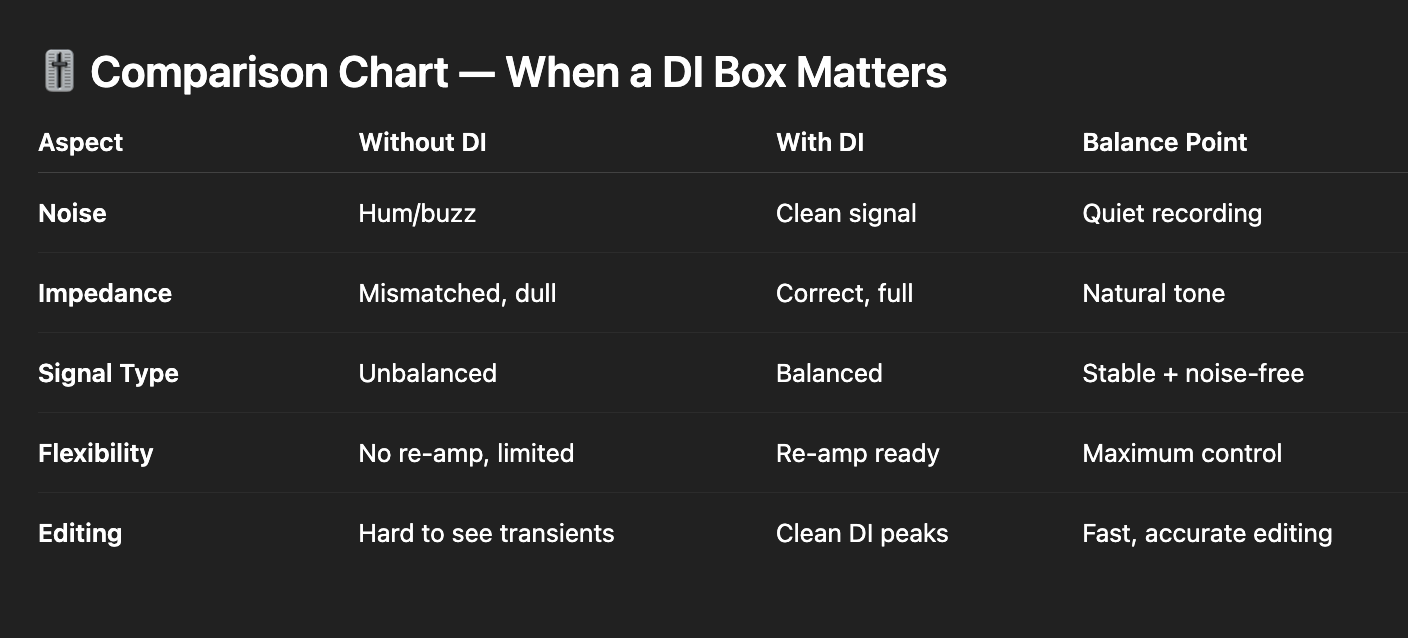Recording: What Is a DI Box and When Do I Need One? 🎛️

Introduction — The Secret Tool Behind Clean, Clear Recording
Every studio — from bedroom setups to world-class rooms — relies on one small, essential box that quietly saves recordings every single day:
the DI box.
Whether you're recording guitar, bass, keyboards, synths, drum machines, or even running audio through pedals, the DI is what makes the signal clean, quiet, consistent, and mix-ready.
It solves noise.
It solves tone loss.
It solves impedance mismatch.
And it unlocks powerful workflows like re-amping and precision editing.
Let’s break it down.
Quick Summary
👉 A DI box (“Direct Injection”) converts an unbalanced, high-impedance instrument signal into a balanced, low-impedance mic-level signal so it can travel cleanly into a recording interface or mixing desk. It improves tone, reduces noise, matches levels, and enables re-amping and clean editing.
🎚️ 1. What “Direct Injection” Actually Means
The term Direct Injection (or Direct Input) describes sending an instrument directly into the recording system without needing an amplifier first.
Instead of using a loud amp and microphone, a DI lets you inject the instrument signal straight into the mixer, interface, or preamp.
This gives you:
-
a clean recording
-
stable levels
-
zero amplifier noise
-
maximum flexibility later
Musicians often shorten the phrase to simply: DI.
10 Universal Rules for Recording Anything with a Microphone 🎤
🎚️ 2. Unbalanced vs. Balanced Signals
Understanding DI boxes starts with understanding these two types of signals:
Unbalanced Signal
Common in: guitars, basses, keyboards, pedals
Runs through: TS instrument cables
Problems:
-
picks up noise
-
weak against long cable runs
-
hum and buzz are common
Balanced Signal
Common in: microphones, DI outputs, pro audio lines
Runs through: XLR cables
Benefits:
-
noise-rejection (thanks to differential wiring)
-
clean signal over long distances
-
stable, professional level
Why the DI matters:
A DI converts your unbalanced signal into a balanced one so you can record cleanly.
Recording Vocals for Dummies: How to Get Started
🎚️ 3. High Impedance vs. Low Impedance
Now the second core concept: impedance.
High Impedance (Hi-Z)
-
guitar/bass pickups
-
unbuffered pedals
-
certain synths
-
fragile signal
-
loses tone if plugged into the wrong input
Low Impedance (Low-Z)
-
microphones
-
balanced professional lines
-
stable
-
ideal for clean recording
Why the DI matters:
A DI matches the impedance of your instrument to the impedance of your interface or preamp.
This preserves clarity, bass response, and dynamics.
 ⭐️ Download my Free Guide The Magic EQ Settings that work on EVERYTHING!
⭐️ Download my Free Guide The Magic EQ Settings that work on EVERYTHING!
🎚️ 4. Passive DI vs. Active DI
Like guitar pickups, microphones, and studio monitors, DI boxes come in two types: Some that require power and some that don't.
Passive DI
-
simple transformer-based design
-
no power required
-
smooth tone
-
handles loud, hot signals well (keyboards, synths, basses)
Good analogy:
Passive DI = passive pickups
-
warm
-
musical
-
forgiving
Active DI
-
powered (phantom power, battery, or wall power supply)
-
includes active circuitry
-
boosts and buffers weak signals
-
best for low-output instruments like passive basses or guitars
Analogy:
Active DI = active pickups
-
clean
-
bright
-
detailed
Quick Rules of Thumb
A passive DI is totally fine for everything but you can also use this approach:
-
Passive instrument → Active DI
- Active instrument/synth → Passive DI
🎚️ 5. Using a DI Box With Guitar & Bass Amps
When recording guitar or bass, engineers often record:
-
one DI track
-
one or more mic tracks from the amplifier
This gives the best of both worlds:
-
amp tone (character, distortion, air, movement)
-
DI tone (clean, punchy, flexible)
You typically plug the instrument into the DI first, then use the DI’s Thru or Link output to feed the amplifier.
🎚️ 6. Why Bass Tones Are Often Blended
For professional bass recordings, the DI is crucial.
Bass tones are usually a blend of:
-
clean DI (punch, clarity, transient definition)
-
amp mic (growl, color, warmth)
-
sometimes pedal distortion track
The DI carries the focus and low-end stability.
The amp adds flavor.
This blend is the standard across rock, pop, metal, R&B, and modern production.
 ⭐️ Start by downloading all of my FREE Music Production Guides ⭐️ It took me years to learn this stuff!
⭐️ Start by downloading all of my FREE Music Production Guides ⭐️ It took me years to learn this stuff!
🎚️ 7. Electric Guitar: When the DI Track Isn't Used
For standard electric guitar recording, the DI is not used in the final mix.
Why?
Because clean DI electric guitar (without amp simulation) sounds:
-
dry
-
flat
-
stringy
-
“funk only”
But engineers still record the DI anyway — not for tone, but for workflow.
🎚️ 8. Re-amping: The Real Power of the DI Track
Recording a DI opens the door to re-amping, one of the most powerful tools in modern production.
With a DI track, you can later send the clean signal out into:
-
a real amp
-
an amp simulator pedal
-
a re-amp box
-
software plugins
-
any combination of tones
This lets you change guitar or bass tones after the performance.
No pressure.
No regret.
No commitment too early.
This is how major producers build album-ready tones.
From Dull to Harsh: How to Choose the Best Microphone for Any Voice or Instrument 🎙️
🎚️ 9. Editing: Why DI Tracks Make Life Easier
Distorted or heavily colored amp tracks often hide transients.
This makes editing hard.
The DI track, however, shows:
-
clear transients
-
obvious pick attacks
-
clean rhythms
-
visible timing information
For tight editing — especially in rock, pop, metal, and modern bass production — the DI is the guide track.
🎚️ 10. Track Management: Group Before You Edit
Once you're ready to edit, group the DI and amp mic tracks together.
This ensures:
-
timing edits apply to all tracks
-
phase stays aligned
-
re-amping stays locked
-
tone remains consistent
Never edit DI and amp tracks separately — they must move as one.
🧠 FAQ
Q: Do I always need a DI box?
A: Only if your instrument is unbalanced/high-impedance or you're running long cables. Keyboards and active basses often benefit from a DI too.
Q: Can I record guitar without an amp using only a DI?
A: Yes, but you’ll want a plugin or amp sim — the raw DI tone isn’t meant to be the final sound.
Q: Should beginners buy a passive or active DI?
A: Active DI for passive guitars/basses. Passive DI for synths, keyboards, and active pickups.
Q: Why do live engineers love DI boxes?
A: They eliminate noise, allow long cable runs, and make levels predictable.
 ⭐️ Take my Free Ableton Live Online Course and make your first song in 90 minutes
⭐️ Take my Free Ableton Live Online Course and make your first song in 90 minutes
🔑 Why This Matters
The DI box is one of the simplest tools in recording — but also one of the most powerful.
It protects your tone.
It keeps your sessions flexible.
It makes editing cleaner.
It enables re-amping.
It reduces noise.
When in doubt, record the DI.
You’ll always be glad you did.
⭐️ Download my Free Magic Delay settings Guide ⭐️
⭐️ Download my Free Magic Reverb settings Guide ⭐️
#protools #daw #homestudio #recordingschool #recording #musicproduction
Also read:
How to Start Your Own Online Business Teaching Music

Hey, I'm Futch - Music Production Coach and Ableton Certified Trainer
Learn how to make your first song and beat in Ableton Live with my
FREE 90-minute Ableton Live course
I've been teaching audio engineering and music production for 35 years.⭐️
Check out my new online music production program: Music Production Ninja...








